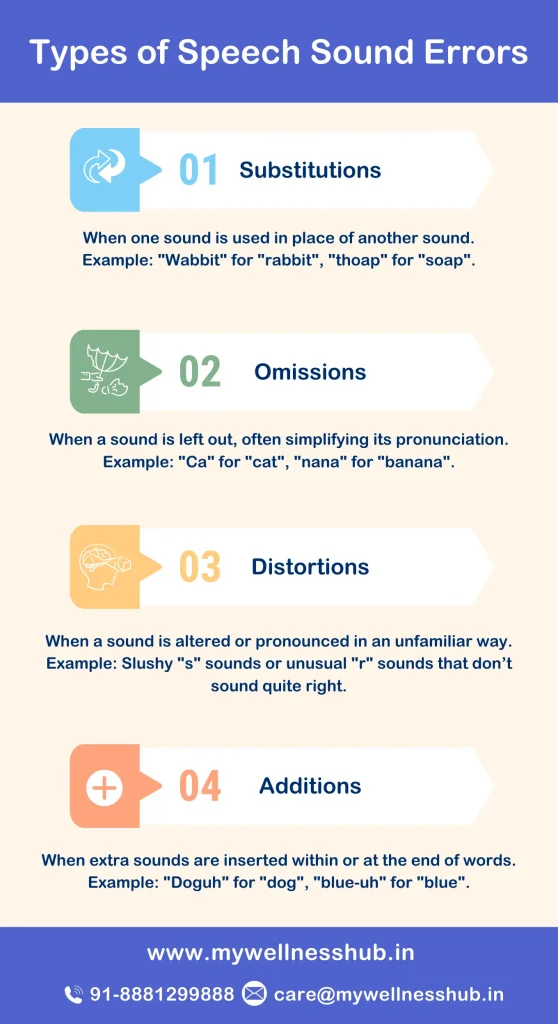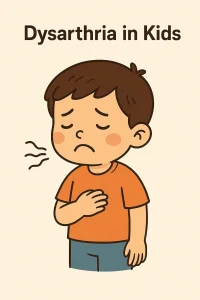Speech Sound Errors in Children: Milestones and When to Seek Help
By Wellness Hub
Last Updated: December 27, 2024
Watching your child transition from babbling to speaking full sentences is both exciting and nerve-wracking. Mispronunciations are common, but how do you know when they’re just a phase or a sign of a speech sound error? Understanding speech development milestones helps you recognize when to seek help. Early intervention is crucial, as timely support can significantly enhance your child’s communication skills, impacting their social interactions and academic success.
Book Your Free Speech Therapy Consultation
What Are Speech Sound Errors?
Speech sound errors occur when children deviate from the typical pronunciation patterns expected at their age. These mispronunciations are a normal part of language development, but sometimes they linger longer than they should. Common examples include:

- Substitutions: Replacing one sound with another, such as saying “wabbit” instead of “rabbit.”
- Omissions: Dropping sounds within words, making “cat” sound like “ca.”
- Distortions: Altering the sound, so “shoe” might sound slushy or unclear.
- Additions: Adding extra sounds to words, turning “blue” into “balue.”
Also Read: Speech Sound Disorders: Causes, Treatment and Strategies
Causes of Speech Sound Errors
The reasons behind speech sound errors can be as diverse as the children themselves. Here’s a brief overview of the potential causes:
- Genetic Factors: Like many aspects of development, speech can be influenced by genetics. Family history of speech and language disorders can play a role.
- Developmental Factors: Each child develops at their own pace, but significant delays in milestones might indicate underlying issues.
- Environmental Factors: The environment, including how much verbal interaction a child experiences daily, significantly impacts speech development. Limited exposure to language and conversation can delay speech skills.
Typical Speech Development in Children
Speech Milestones from Infancy to School Age
Tracking your child’s speech development helps you support their communication skills effectively. Here’s a straightforward guide to typical speech milestones:
- By 12 Months: Babies often say “mama” and “dada” and understand simple requests.
- By 24 Months: Toddlers might know around 50 words and start putting two words together, like “more milk.”
- By 3 Years: Children usually talk in three-word sentences, know about 1,000 words, and are mostly understandable to others.
- By 4 Years: They can make five or six-word sentences, use complex grammar, and are mostly clear to listeners.
- By 5 Years: Most children speak clearly with full sentences and have mastered nearly all speech sounds, though some might still mix up sounds like “r,” “l,” or “th.”
Speech Development Milestones from 0 to 5 Years
| Age | Milestones | Common Errors | Visuals |
| 0-12 Months | Babbling, first words (“mama”, “dada”) | Limited babbling, using only vowels | Baby smiling, babbling |
| 12-24 Months | Simple words, starts combining words | Omitting sounds in words | Toddler playing, speaking |
| 2-3 Years | Two to three-word sentences, vocabulary expands | Substituting hard sounds (e.g., “wabbit”) | Child interacting, using sentences |
| 3-4 Years | Questions, clear sentences, understands rules | Distorting complex sounds (e.g., “l”, “r”, “s”) | Preschooler in conversation |
| 4-5 Years | Full sentences, clear speech, understands jokes | Minor issues with fluid speech, occasional stammering | Child telling stories, joking |
Normal Vs. Concerning Speech Patterns
It’s important to know the difference between typical speech habits and signs of a speech disorder:
- Normal Mispronunciations: Young kids often make mistakes with tricky sounds. For example, saying “wabbit” instead of “rabbit” is common and usually gets better by age 5.
- Concerning Speech Patterns: If speech issues don’t improve or if your child shows these signs, it might be a concern:
- Not making sentences by age 3.
- Getting upset or avoiding talking because others can’t understand them.
- Often leaving out sounds or parts of words.
Recognizing Speech Sound Errors in Your Child
Common Speech Sound Errors by Age
As children grow, their speech development follows a predictable pattern, but it’s not uncommon for them to make mistakes along the way. Here’s what you might expect at different ages:
- Under 3 Years: Common errors include leaving off ends of words or simplifying complex words. For example, “banana” might be pronounced as “nana.”
- 3 to 4 Years: Children might struggle with sounds that require more precise tongue placement like “r,” “l,” “s,” and “th.” “Rabbit” might come out as “wabbit.“
- 4 to 5 Years: Errors begin to resolve, but some children might still mix up sounds, especially in longer words or when speaking quickly.
Signs That It’s Time to Seek Help
While it’s normal for young children to make speech errors, some signs suggest it might be time to consult a professional:
- Persistent Errors: If speech errors continue past the expected age of correction — for example, mispronouncing “r” and “l” sounds beyond age 5.
- Difficulty Being Understood: By age 4, strangers should understand most of what your child says. If clarity isn’t improving, it could indicate an issue.
- Frustration or Avoidance: If your child avoids talking or shows signs of frustration during communication, it could be a sign that they’re struggling more than typical development would suggest.
Addressing Speech Sound Errors
When to Contact a Speech-Language Pathologist
It’s essential to know when to seek a professional evaluation for your child’s speech sound errors. Here are some guidelines to help you decide:
- Age Considerations: If your child is still struggling with certain sounds past the typical age for mastering them—such as ‘s’ or ‘r’ sounds by age 5—it’s a good time to consult a speech-language pathologist.
- Communication Impact: Consider how the errors affect your child’s ability to communicate effectively. If they are frequently misunderstood by family, friends, or teachers, it might be time for professional help.
- Social and Emotional Effects: Pay attention to whether speech issues are impacting your child’s social interactions or self-esteem. Children who are aware of their speech difficulties and feel embarrassed or frustrated are candidates for a consultation.
Treatment Options for Speech Sound Errors
Once a speech sound error is identified, there are several treatment options to consider, depending on the nature and severity of the error:
- Articulation Therapy: This involves exercises to help your child learn the correct way to make sounds. These exercises may include demonstrating how to move the tongue to produce specific sounds.
- Phonological Therapy: This treatment targets patterns of sound errors. For example, if your child drops consonants at the ends of words, therapy will focus on teaching the rules of speech sound production.
- Interactive Language Games: These are designed to make the learning process fun and engaging, encouraging children to practice new sounds in a playful environment.
Conclusion
Keeping an eye on your child’s speech development is key. If you notice your child struggling with speech, early help is crucial. Quick action can really boost their confidence and communication skills. At Wellness Hub, we offer tools and expert advice to guide you. From understanding speech milestones to accessing effective treatments, we’re here to support you and your child every step of the way.
Frequently Asked Questions:
1. What are common speech sound errors in young children?
Many children make speech sound errors as they learn to talk. Common errors include substitutions (saying “wabbit” instead of “rabbit“), omissions (leaving out parts of words like “nana” for “banana“), distortions (changing the sound slightly), and additions (adding extra sounds to words). These are typical during early speech development.
2. When should I worry about my child’s speech errors?
It’s time to seek advice if your child’s speech errors continue beyond the expected age for correcting them (typically by age 5), if they’re frequently misunderstood, or if their speech issues seem to frustrate them.
3. How can I tell if my child’s speech development is on track?
Check if your child is hitting key speech milestones: saying simple words by their first birthday, combining words by two, forming sentences by three, and speaking clearly by four. If they lag significantly behind these milestones, consider consulting a speech-language pathologist.
4. What does a speech-language pathologist do?
A speech-language pathologist evaluates and treats speech, language, and communication disorders. They work with children to improve their speech clarity, enhance language development, and resolve speech sound errors through personalized therapy plans.
5. At what age are speech sound errors no longer normal?
Most speech sound errors should resolve by age 5. Persistent errors, particularly those that make your child hard to understand, may require professional evaluation and intervention.
6. How do I help my child with speech sound errors at home?
Engage your child in conversation often, read together daily, and play sound games to encourage correct pronunciation. Repeat words correctly without criticizing to model proper speech. Seek resources and activities recommended by speech therapists to support development.
7. What are the signs that my child might need speech therapy?
Signs include persistent speech errors beyond the typical age, difficulties being understood by others, avoiding talking due to frustration, or showing emotional distress related to speaking.
8. Can speech sound errors affect my child’s learning?
Yes, speech sound errors can impact a child’s ability to communicate effectively, which can hinder learning and social interaction. Addressing these errors early can improve their ability to participate fully in educational settings and social situations.
9. What treatment options are available for speech sound errors?
Treatment options include articulation therapy to correct sound production, phonological therapy to address patterns of sound errors, and language intervention activities to improve overall communication skills. Therapies are often tailored to a child’s specific needs.
10. How often should my child see a speech therapist?
The frequency of speech therapy sessions depends on the severity of the speech issues and the specific needs of your child. Some children may see improvements with weekly sessions, while others might need more frequent intervention. A speech-language pathologist can recommend a schedule based on a detailed assessment.
About the Author:
Rajini Darugupally
M.Sc., Speech-Language Pathologist (9+ years of experience)
Rajini is a passionate and dedicated Speech-Language Pathologist with over 9+ years of experience, specializing in both developmental speech and language disorders in children and rehabilitation in adults. Currently, at Wellness Hub, she thrives in a team environment that values innovation, compassion, and achieving results for their clients.
Book your Free Consultation Today
Parent/Caregiver Info:
Client’s Details:
* Error Message









